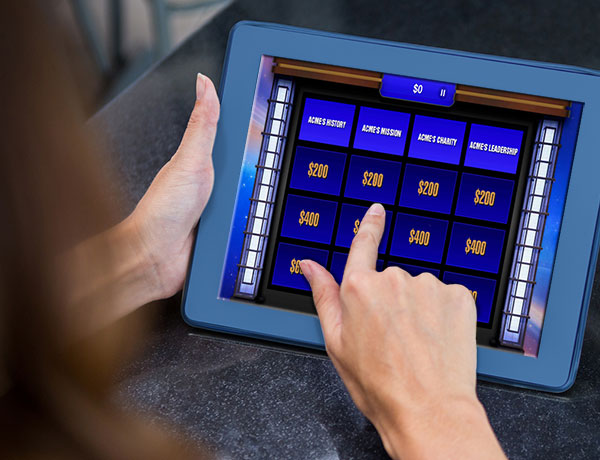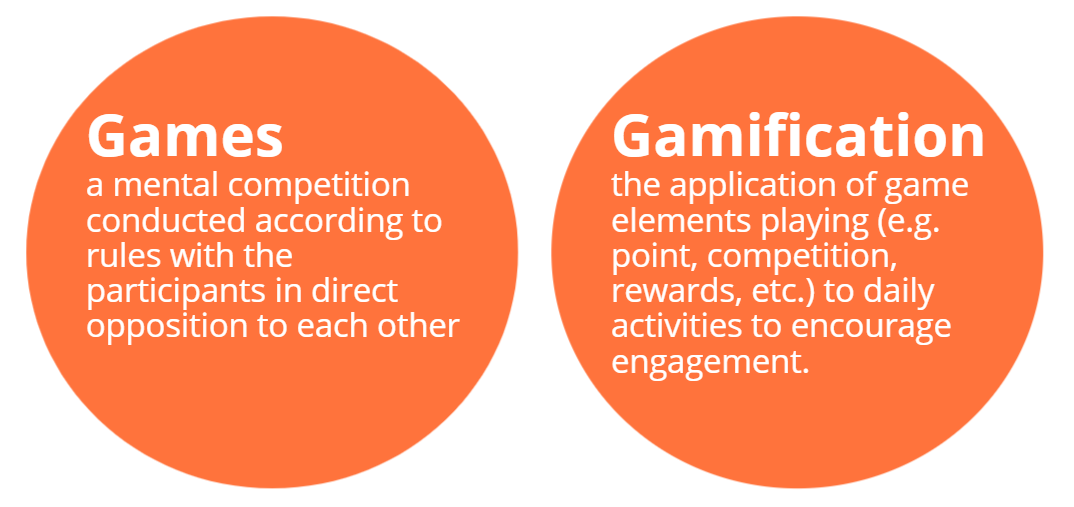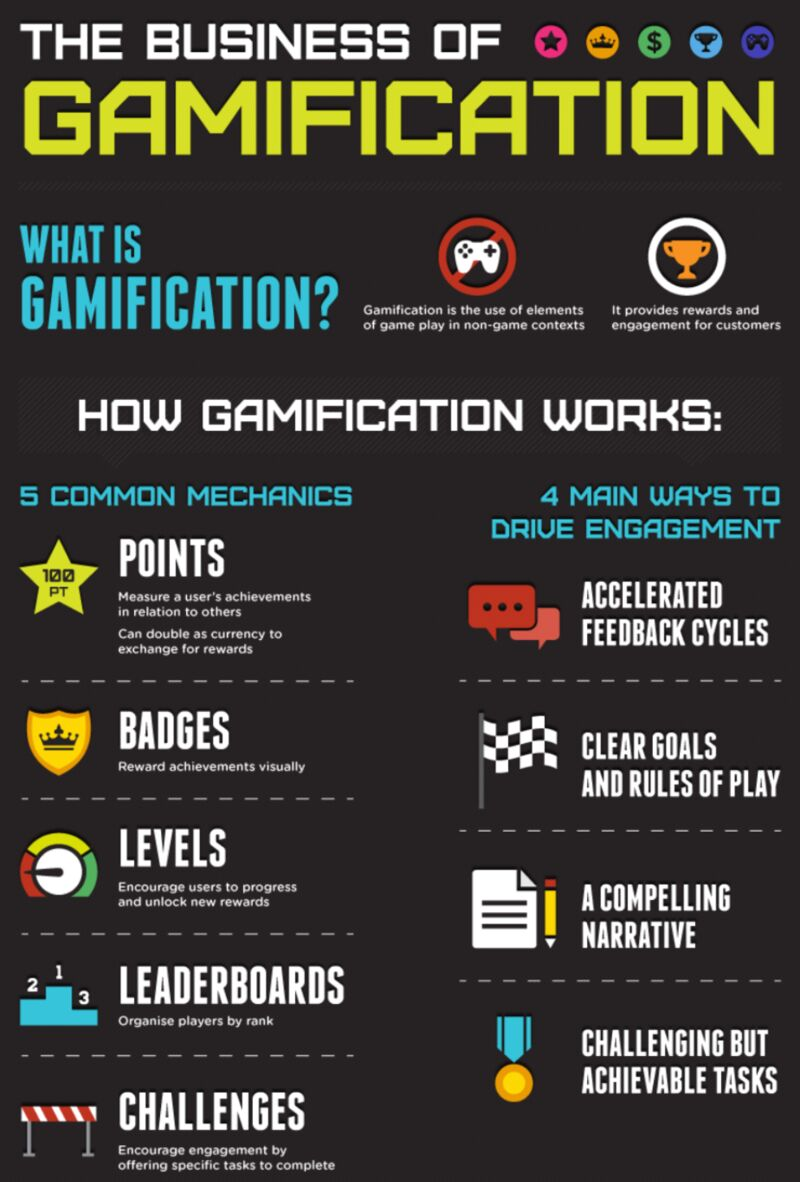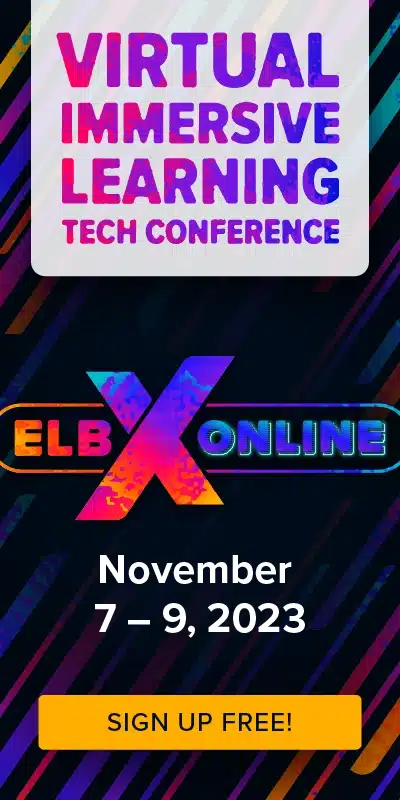Gamification, gamified learning, gamify your training; what does it all mean?
Whether it’s a lunch and learn, your faculty meeting, or an article in your LinkedIn feed, you’ve seen the term gamification. You’re probably wondering how you could implement it into your training program.
Gamification applies gameplay elements (points, competition, rewards, etc.) to real-world situations. Simply using games in your training is not the same thing as implementing a gamification strategy.
There is a subtle but important difference between games and gamification.
Gamification is Everywhere
Chances are you’ve engaged with gamification recently and didn’t even realize it. Gamification elements are proven to motivate customers to spend, exercise, save their money or engage with a brand. It appears in loyalty programs, exercise apps, Fintech saving apps, and eCommerce websites.
For instance:
- Save more money to level up
- Spend $100 and get 100 points
- Take 12,000 steps to unlock a lower interest
- Spin the wheel to get a percentage off your purchase
- If you’re a Peloton rider, you’ve also been motivated by gamification
These gamification techniques make you feel like you’ve earned something by doing nothing, and you’re motivated to spend again. All the while, you’re having fun and getting a little rush every time you rack up those points. Perhaps the best example of corporate gamification is something we’ve all likely played; the McDonald’s Monopoly game.
Training Games Can Help Increase Sales
As a kid, I always asked my mother for just one more order of french fries, just one more apple pie in hopes of finding that mythical Boardwalk piece. There was the rush of peeling back the tab, the anticipation of a grand prize, and then disappointment when it was another Baltic avenue! So, you know what I did? I asked for another order of french fries so I could play again.
McDonald’s regularly sees as much as a 6% increase in sales when running Monopoly. They harnessed the power of gamification and drove engagement with their product by utilizing a game everyone knows and plays, Monopoly.
By incorporating games into your training, you can boost engagement like McDonald’s used Monopoly to boost sales. Familiar games like JEOPARDY!® or Wheel of Fortune® can increase a desire to participate and learn. Plus, everyone can feel like they’re living out a gameshow fantasy while participating in a training session at the same time.
Using Gamification in Corporate Training
Walter Gill – the lead instructional designer at Barclaycard – had to ensure that 17,000 domestic and international sales agents were excited and engaged with their training materials. He built a Trivia game of questions asked by customers and used gamification —a leaderboard—to drive engagement.
“I hear from managers that the agents love this format,” he said. Plus, he sees the data. Even though agents pass the trivia game, they take it again multiple times to do better on the leaderboard. By using gamification, Gill was able to harness the natural competitiveness of his sales team to increase performance while also driving engagement with his training material.
Gill is not alone in seeing this repeat engagement. We did a 500 game study, using games like Trivia or JEOPARDY! and saw a significant percentage of learners engage with the training material more than once. Also, there is a measured increase in accuracy as learners continue to play training games.
We’ve now seen a few examples of gamification and where they work. Now, let’s get to how you can use gamification in your own training.
Turn a Zoom call into a fun, team-building activity by using training games such as JEOPARDY!® Heard enough? You can start harnessing the power of games for your training today. Get in touch with an expert today to see how games can improve your training or lesson.
How Do You Use Gamification?
Let’s look at some gamification mechanics and how they drive engagement in the learning experience. Here are five game elements for a lesson or training plan.
1. Points
Points are particularly motivating for people who love to see their name at the top of the leaderboard, remember how effective this was for the Barclayland sales team. Those who are less comfortable with competition can use points to gauge their own achievement or see improvement over time.
Points can also drive repeat play. Seeing a coworker beat your high score might encourage you to play that game again. You’ve got to show them who truly has the best skills. As a training manager, using points will encourage the learner to re-engage with the material and further enhance retention.
In addition, you can use points as a form of currency to exchange for badges or tangible rewards. How many times do you think a learner will want to go back and reread a PowerPoint or a training manual? With a gamified training strategy, the higher the rewards, the more likely your learners will continue to play, rack up points, continue to revisit your training games, and retain the material you created.
By incorporating points into your gamified learning, you as a trainer can measure a user’s achievements in relation to others or foster healthy competition in the learners that are motivated in this way.
2. Badges
Badges can be publicly displayed on a gamified learning platform like Arcades™ and serve as another powerful element in encouraging engagement. Video games often use achievements or trophies to promote particular gameplay styles or feats. Providing your learners with badges can help guide them down specific learning paths or to certain challenges.
Badges are also bragging rights for your learners to share. There’s nothing wrong with a little healthy competition, and seeing that your coworker or colleague holds a badge you don’t have might encourage you to try that lesson one more time.
3. Levels
Who doesn’t want to level up? Levels encourage users to progress and unlock new challenges, spaces, and rewards. Levels also make the training “bite-sized” and offer natural breaks or stopping points. Learners can quickly answer an email or let the dog outside, or do whatever they need to do for a brief minute before returning to the training.
This idea of “bite-sized” learning is called microlearning. Microlearning makes training manageable and digestible. This is particularly appealing to younger generations and their increasingly short attention spans. By playing one level, you and your learners can drill down on the goal of that lesson before moving on to the next.
4. Leaderboards
We’ve touched on this a few times earlier, but what good is having a high score if you can’t tell everyone about it? Having a leaderboard encourages healthy competition among your competitive learners and gives non-competitive learners a way to measure success. Either way, using a leaderboard based on points will drive repeat play and more interaction with your training materials.
As much fun as it is at the top, might we suggest not showing the whole leaderboard to save those at the bottom? Broadcasting that a particular learner has a low score probably isn’t ideal in making sure they feel safe in their learning. But as a trainer, looking at points and leaderboards can help you focus your attention on learners near the bottom who might struggle with the lesson.
5. Challenges
A PowerPoint, lecture, or reading a training manual is passive and does not give your learners any real stakes in their training. I myself am guilty of “clicking-through” plenty of online resources that didn’t engage me.
Games and gamification allow you to put the learner in the center of the action, overcome obstacles, and face success and failure without suffering consequences. Clicking “next” or turning the page isn’t that fulfilling. Solving a puzzle to unlock the next level, or completing a challenge in a certain amount of time to earn a badge, provides immediate gratification and feedback to your learners.
Even if they fail a challenge, learners will want to try again, and they can do it immediately. Remember as a kid I wanted just one more order of french fries from McDonald’s? The need for “just one more level” is accurate, and if you can harness this mechanic of gamification, you’re already on your way to increasing engagement.
This combination of challenge, feedback, and engagement creates a much more memorable experience.
Applying gamification could be the best way to boost your return on investment as a trainer or educator. Heard enough? You can start harnessing the power of games for your training today. Get in touch with an expert today to see how games can improve your training or lesson.
Four Ways Gamification Drives Engagement:
1. Accelerated feedback cycles
A considerable benefit of games is the instant feedback and data you receive as a trainer. You automatically have actionable data points to improve your training further, measure KPI and ROI, and prove to your boss that the investment in “video games” was, in fact, a great decision.
In addition, you can embed feedback for your learners right into the game. Did they get a question wrong? Insert a feedback card so they can instantly learn why the answer was wrong and improve upon it for next time. Without this instant response, feedback can take hours, if not weeks, to reach learners. Once the moment has passed, they may not remember the question or exercise.
2. Clear goals and rules
It’s truly frustrating to feel “lost” in a video game. The same rings true for your gamified training. Consider adding hints, “calls to action,” or prompts to guide users along, especially if the path isn’t intuitive or clear. Give your learners specific, achievable tasks to encourage them to engage with the training.
Leaving things too open-ended can make learners feel confused and reduce their willingness to engage with the material. Instead, they only remember that they “didn’t know what to do” during their gamified learning.
3. A compelling narrative
You don’t continue watching a movie or show without great characters and plotlines. Then why would you continue a video game or gamified learning without the same narrative? Especially in role-playing or scenario-driven games, make sure to create conflict that makes any story interesting.
By making your learners characters in a game, you’ve also given them agency. Watching a movie is great, but making the decisions that impact the character – and the consequences that follow – dramatically increases a desire to engage. An engaged learner is an effective learner.
4. Challenging but achievable goals
Sure, some of us like an impossible challenge, but after having to reload that checkpoint for the hundredth time to beat the final boss, things get frustrating. At that point, you’re not having fun; you’re just trying to beat the darn thing.
Apply that same concept to your gamified learning. Make sure your game and training push but don’t break your learners. A challenging task or game is far different than an impossible one.
Harness the Power of Gamification
Actionable data from games
Games don’t only provide immediate feedback to your learners; you, as the trainer, instantly have usable, actionable data to help improve your training. If you see many learners failing specific questions, perhaps the material wasn’t covered well enough or is too difficult.
Or, perhaps the opposite is true. If no one is losing your games or failing puzzles, maybe they’re too easy. Or, maybe your training was just that good! We leave that for you to decide.
This is just a small sample of the data collected in the Arcades platform™ that can help you craft and improve your training material based on user performance.
Using games and gamification software shows you how often your learners play your games, their accuracy, and specific data on each user. If you have a PowerPoint presentation to click through, you might not know who completed it. With games, you can see how long they spent on each puzzle, question, or level, their answers, how many times they played, their improvement over time, and more.
Use games in your training today
By incorporating the mechanics and goals above, you will be well on your way to empowering your learners with gamification. Whether you want to gamify your classroom, educate your sales team, or improve a virtual meeting, games will boost engagement, effectiveness, and your learners will have fun.
Check out our do-it-yourself gamification platform, The Training Arcade®. Click here to schedule a demo and start your free trial today.







